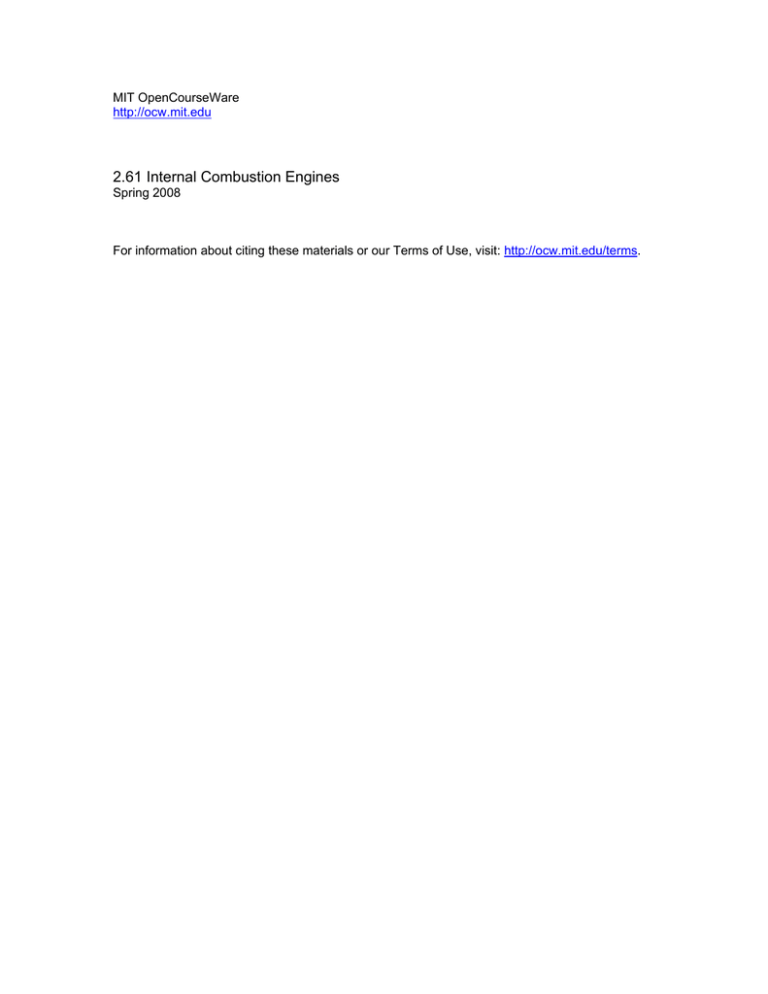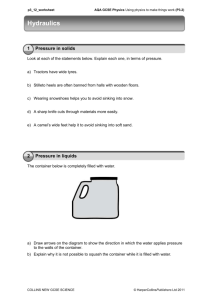2.61 Internal Combustion Engines
advertisement

MIT OpenCourseWare http://ocw.mit.edu 2.61 Internal Combustion Engines Spring 2008 For information about citing these materials or our Terms of Use, visit: http://ocw.mit.edu/terms. MASSACHUSETTS INSTITUTE OF TECHNOLOGY Department of Mechanical Engineering 2.615 INTERNAL COMBUSTION ENGINES Homework Set #9 Due: 5/13/08 Problems: 1. The purpose of this problem is to let you have a feel for the magnitudes of the heat load under typical engine condition. Use the spark ignition engine data from HW4 (on the web) for your calculation; assume that the volumetric efficiency based on intake condition is 0.7. The overall heat transfer correlation is given by = hA(T − T ) Q g w where A is the surface area (estimated by assuming a flat piston and a flat head), and h is calculated from the Nusselt correlation Nu = 0.35Re 0.8 Pr 0.4 The Reynolds number is based on the mean piston speed and bore diameter. The Prandtl number is 0.8. Note that the heat transfer correlation used in the problem is based on the average gas temperature, which can be estimated from the burned and unburned gas temperatures. To simplify the problem, you may use constant values for the gas properties: Specific heats cp,unburned =1.2 kJ/kg; cp,burned = 1.5 kJ/kg. Viscosity μ = 7x10-5 kg/m-s Thermal conductivity k = 0.15 W/m-K Average molecular weight = 29 The average wall temperature is 400K. and the cumulative heat transfer Q as a Plot as a function of the crank angle, the values of: A, h, Tg - Tw , Q function of crank angle from when the intake valve closes to when the exhaust valve opens. (In the data file, TDC compression is 360o; IVC at 234o; EVO at 483o.) Note that the Q you calculated is the overall heat transfer based on the average gas temperature. There is a Q listed in the data file; that value is based on the heat transfer from the burned gas through the “wetted” area the burned gas covers. You should compare the two values. You should also note that the Q values you calculated are based on time and those listed in the file are crank angle based so that conversion is needed before you can compare them. 2. The lubrication film under the top piston ring will break though somewhere near the end strokes where the the piston velocity is low. The resulting boundary lubrication manifests as liner wear, of which the wear pattern can be seen when the engine is disassembled. The wear near TDC is more severe than that near BDC because the ring pressure is higher. This phenomenon could be interpreted by the Stribeck diagram (see Fig. 13-3). For the piston ring, the non-dimensional Sommerfeld number S (which is graphed as the x-axis of the Stribeck diagram): S= μU(θ) aP(θ) where μ is the lubricant viscosity, a is the piston ring thickness, and U(θ) and P(θ) are the instantaneous piston speed and cylinder pressure at crank angle θ. Film break through occurs when S is less than a critical value Scritical. For the pressure data of HW4, plot S as a function of θ for a = 1 mm; μ = 0.01 Kg/m-s. If Scritical = 1, where are the transition points (in terms of CA) near TDC in the compression and expansion strokes under the following conditions (a) (b) (c) Under the operating condition of the data file. When the speed is increased from 1500 rpm to 4500 rpm at the same load When the load is increased by a factor of 2. In these calculation, the shape of P(θ) may be considered the same; thus for part (c), the pressure curve will be scaled by a factor of 2.











